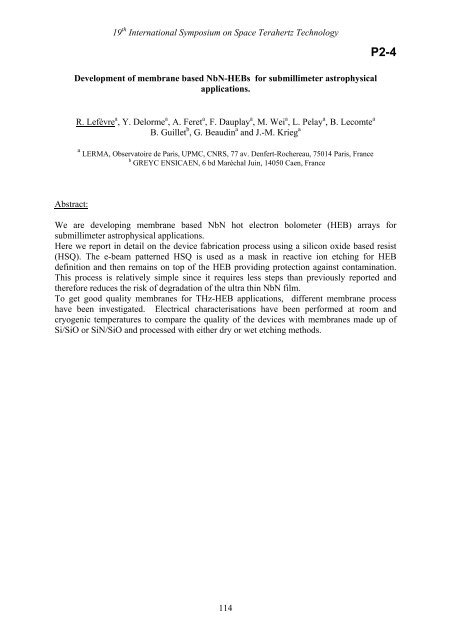Program and Abstract Book - SRON
Program and Abstract Book - SRON
Program and Abstract Book - SRON
Create successful ePaper yourself
Turn your PDF publications into a flip-book with our unique Google optimized e-Paper software.
19 th International Symposium on Space Terahertz Technology<br />
P2-4<br />
Development of membrane based NbN-HEBs for submillimeter astrophysical<br />
applications.<br />
R. Lefèvre a , Y. Delorme a , A. Feret a , F. Dauplay a , M. Wei a , L. Pelay a , B. Lecomte a<br />
B. Guillet b , G. Beaudin a <strong>and</strong> J.-M. Krieg a<br />
a LERMA, Observatoire de Paris, UPMC, CNRS, 77 av. Denfert-Rochereau, 75014 Paris, France<br />
b GREYC ENSICAEN, 6 bd Maréchal Juin, 14050 Caen, France<br />
<strong>Abstract</strong>:<br />
We are developing membrane based NbN hot electron bolometer (HEB) arrays for<br />
submillimeter astrophysical applications.<br />
Here we report in detail on the device fabrication process using a silicon oxide based resist<br />
(HSQ). The e-beam patterned HSQ is used as a mask in reactive ion etching for HEB<br />
definition <strong>and</strong> then remains on top of the HEB providing protection against contamination.<br />
This process is relatively simple since it requires less steps than previously reported <strong>and</strong><br />
therefore reduces the risk of degradation of the ultra thin NbN film.<br />
To get good quality membranes for THz-HEB applications, different membrane process<br />
have been investigated. Electrical characterisations have been performed at room <strong>and</strong><br />
cryogenic temperatures to compare the quality of the devices with membranes made up of<br />
Si/SiO or SiN/SiO <strong>and</strong> processed with either dry or wet etching methods.<br />
114
















